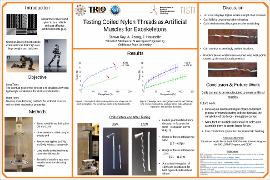| dc.contributor.advisor | Hausselle, Jerome | |
| dc.contributor.advisor | Azoug, Aurelie | |
| dc.contributor.author | Ray, Shawn K. | |
| dc.contributor.other | Biomechanical Analysis and Musculoskeletal Modeling Lab of Oklahoma State University | |
| dc.contributor.other | Mechanics of Smart and Soft Materials Lab of Oklahoma State University | |
| dc.date.accessioned | 2021-03-25T14:28:52Z | |
| dc.date.available | 2021-03-25T14:28:52Z | |
| dc.date.issued | 2019-10-05 | |
| dc.identifier | oksd_OK-LSAMP_2019_ray | |
| dc.identifier.citation | Ray, S., Azoug, A., & Hausselle, J. (2019, Oct. 5). Testing coiled nylon threads as artificial muscles for exoskeletons. Poster session presented at the Oklahoma Louis Stokes Alliance for Minority Participation's 25th Annual Research Symposium, Stillwater, OK. | |
| dc.identifier.uri | https://hdl.handle.net/11244/329034 | |
| dc.description.abstract | The popularity of robotic exoskeletons in rehabilitation is on the rise. However, high cost and bulkiness are two limitations that hinder their popularity and everyday use. Our overarching goal is to develop a low-cost lightweight exoskeleton for stroke rehabilitation. Researchers have developed a method to transform fishing lines into artificial muscles. The goal of this project was to manufacture muscle fibers and test their mechanical properties, specifically the maximum force they can withstand before failing. Two types of fishing line (53 and 111 N) were coiled using a hand drill and weights of 170g and 240g, respectively. We then used a tensile machine to measure the force at failure for ten fibers of each type to assess the consistency of our manufacturing method. The line rated for 53 N failed at an average force of 6 N (standard deviation: 1 N). As expected, the line rated for 111 N failed at a higher average force of 10 N (standard deviation: 2 N). One of the main results is the rather large standard deviations computed, which ideally will be minimized by a more reliable manufacturing process that will ensure constant coiling speed and line tension. We were able to manufacture muscle fibers from fishing lines and quantified the maximum amount of force they can withstand before failure. Current work focus on understanding the failure mechanisms and building a rig to ensure better manufacturing consistency. Future work will focus on testing additional potentially stronger materials and develop the system to control the fiber contraction. This study represents the first critical step towards designing large artificial muscles. These muscles have the potential to replace the heavy energy-consuming electrical and pneumatic actuators currently used in exoskeletons. | |
| dc.description.sponsorship | Oklahoma Louis Stokes Alliance for Minority Participation Program | |
| dc.description.sponsorship | Robert E. McNair Post-Baccalaureate Achievement Program | |
| dc.description.sponsorship | National Science Foundation (U.S.) | |
| dc.format | application/pdf | |
| dc.language | en_US | |
| dc.publisher | Oklahoma State University | |
| dc.relation | Ray, S., Azoug, A., & Hausselle, J. (2019, July 25). Testing coiled nylon threads as artificial muscles for exoskeletons. Poster session presented at the Oklahoma State University McNair Scholars Summer Research Institute Symposium, Stillwater, OK. | |
| dc.rights | In the Oklahoma State University Library's institutional repository this paper is made available through the open access principles and the terms of agreement/consent between the author(s) and the publisher. The permission policy on the use, reproduction or distribution of the article falls under fair use for educational, scholarship, and research purposes. Contact Digital Resources and Discovery Services at lib-dls@okstate.edu or 405-744-9161 for further information. | |
| dc.title | Testing coiled nylon threads as artificial muscles for exoskeletons | |
| osu.filename | oksd_OK-LSAMP_2019_ray.pdf | |
| dc.description.department | Mechanical and Aerospace Engineering | |
| dc.type.genre | Presentation | |
| dc.type.material | Text | |
| dc.type.material | Image | |
| dc.subject.keywords | artificial muscles | |
| dc.subject.keywords | nylon | |
| dc.subject.keywords | exoskeleton | |
| dc.subject.keywords | rehabilitation | |
